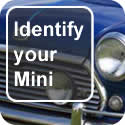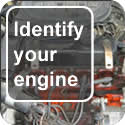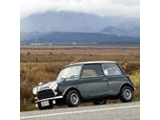
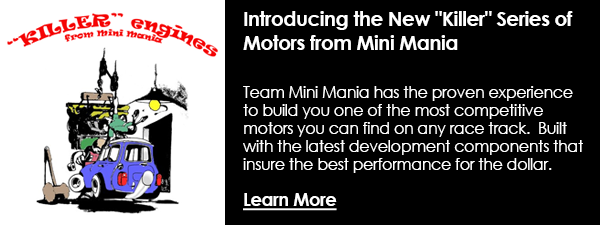
- Introduction
- Getting Started
- Why Correct Identification is Necessary
- What to Know to Identify Minis
- Identification by Chassis Number/VIN – Standard Cars
- Identifying Minis by Engine/Power Unit
- Mini Mini History
- Identifying Minis by Mark
- Identifying Non Standard Minis
- Minis Built for Export and Minis Built Outside of the UK
For 2001 and later model MINIs: Select Your Car
|
Use our Visual Interactive Matrix. Select the Mini identification matrix that fits your needs. |
|
Identifying Minis by Engine/Power Unit
There are some common questions associated with Classic Mini engines/motors that can be answered easily by a quick visual inspection: "A-series or A+?" and "Verto or pre-Verto clutch?". See the simple answers below.
The remainder of the engine identification process becomes a little more challenging. Apart from having to deal with the numerous Mini engines, one must also consider the fact that transverse engines from many other English automobiles of the era found their way into Minis. Initially, the 1100 and 1300 series of automobiles were the most popular (e.g., in the U.S., the MG1100 and Austin America). Later on, the Metro engines became and continue to be a common source of transplants.
If the engine's identification plate remains attached to the block (look just below the number one spark plug), and the plate is original or accurate for the engine, the problem becomes a little bit easier. All that is required is the ability to read the code! Below are sections on Mini and Metro engine numbers. If the engine is not included in the Mini or Metro sections, or if the engine's identification plate is missing, there is a section that will assist you in locating it.
A versus A+
The A+ version of the venerable A-series engine showed up around 1980 and a common identification question is, "How can I tell the difference between an A and A+ engine?" Here are a couple of ways (but there are more):
- Alternator Bracket
-
This one is the easiest and can usually be done even from a photograph of an engine in a car. The A-series engine started life using a generator, which is a couple of inches longer than a Classic Mini alternator. The rear (clutch end) mount was bolted to the side of the engine block a comfortable generator length from the front mounting spot on the water pump – about 6" or so.
By January 1973, when alternators finally became standard on Minis, the mounting points on the block weren’t changed so the bracket had to have an extension to bridge the gap caused by the alternator being about 2" shorter.
When the A+ block was designed, the shorter alternator was taken into account and the mounting points for use of a smaller bracket were moved forward on the block towards the alternator.
So, look for a generator (A-series), or an alternator with a bridging rear bracket (A-series), or an alternator without the bridging rear bracket (A+).
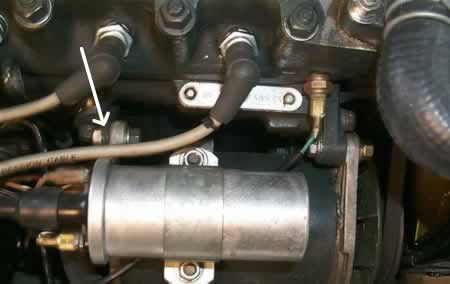
Generator (A-series)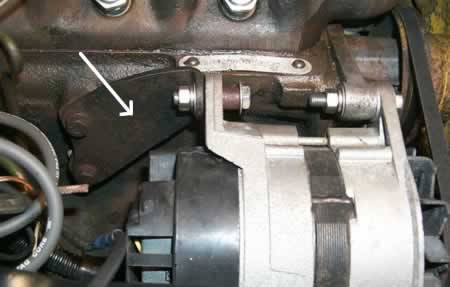
Alternator with a bridging rear bracket (A-series)
-
- Distributor Mount
-
With the advent of the A+, the method of mounting the distributor to the block was changed. Look for a distributor clamp with two bolts holding it to the block (A-series) or only one bolt (A+). This is easy to see if there is no big water shield in the way and if you can get you head under the bonnet, but it usually doesn’t show up in typical engine photographs.
-
Pre-Verto versus Verto Clutch
In 1980, the Classic Mini’s clutch underwent a major change. The internal clutch/ flywheel assembly changed as well as almost all of the external, connecting bits as far back as the master cylinder. They are pretty easy to tell apart with just a quick look inside the engine compartment. Here are two ways. There are others.
- Clutch Arm
-
The clutch arm for the Verto set up is a short, stubby little thing. The exposed length is only about 2" while the pre-Verto clutch arm is closer to 6". Easy to tell. No need to measure.
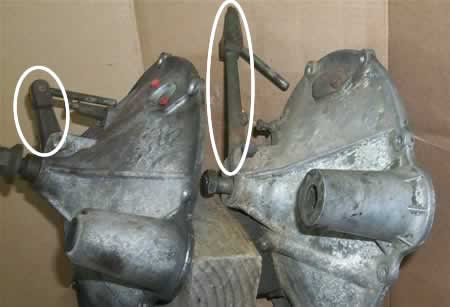
Verto and pre-Verto clutch arms
-
- Clutch Slave Cylinder Mounting
-
The pre-Verto clutch slave is mounted horizontally directly onto the flywheel housing about level with the top of the long clutch arm. With the Verto, the clutch slave cylinder is mounted on a bracket which is mounted on the flywheel housing allowing the clutch slave to point downwards at an angle to meet up with the clutch arm rod coming off the end of the very short clutch arm. The slave cylinders are visibly different, too.
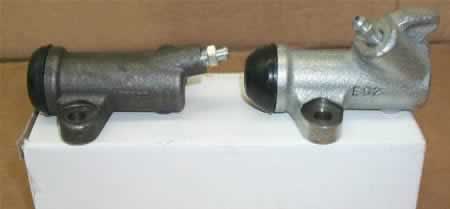
pre-Verto and Verto clutch slave cylinders
-
Engine ID for Standard Mini Engines
There were many versions of the A and A+ series of engines used in Classic Minis over the 40+ years they were produced. If the engine ID tag is still in place then a quick check of the beginning of the engine number will tell you what the engine size is. (If the ID tag is missing, see "Engine ID If the Engine Tag Is Missing"). The short version follows. If the engine number begins with:
| Engine # Prefix | Engine Type |
|---|---|
|
848cc |
|
998cc (non Cooper) |
|
1098cc |
|
1275cc (non Cooper S), except 12H397 & 12H398 (these are "S") |
|
997cc Cooper |
|
998cc Cooper |
|
970 Cooper S |
|
1071cc Cooper S |
|
1275cc Cooper S |
Engine ID for Standard Metro Engines
The Austin, MG, and Mini Metro used various A+ engines for a number of years in 848, 998, and 1275cc forms. These are easily transplanted into Minis and that swap has been popular for a number of years.
Note that 99H and 12H engine numbers were also used for Minis, and also note, that Metro Engines with HE and HF were equipped with lead-free fuel compatible heads.
The short version for spotting a Metro engine from the ID tag is as follows. If the engine number starts with:
| Engine # Prefix | Engine Type |
|---|---|
|
848cc engine
(It is unlikely one is going to find one of these. There were not many produced and they were intended for export outside of the UK.) |
|
998cc engine |
|
1275cc engine |
For more details on the Metro engines built up until October 1984, see on the web site under Articles & News/Calver’s Corner/Engine, “ Engine – Metro engine identification data.” From October 1984 there were about 100 more variations on the Metro engine theme!
Engine ID If the ID Tag Is Missing
If you want to identify the engine in your car and the engine ID tag is missing, all is not lost. You won’t be able to come up with a detailed identification of what is inside, but, in most cases you can come up with the engine series (A or A+ as discussed above), and the engine size.
- Large Bore versus Small Bore
-
A quick look will tell you if the engine is a "large bore" or "small bore" engine. With a rare, South African engine exception, the large bore engines are all Cooper S (970, 1071, and 1275cc) and all non-Cooper S 1275cc engines. Small bore is everything else, 848, 997, 998 (Cooper and non-Cooper), and 1098cc engines.
Another large bore/small bore quick check is to look at the heater hose outlet on the clutch end of the head. (The majority of the engines had an outlet there, but late cars did not.) This assumes that the head has not been switched between large bore and small bore. It is possible to put a large bore head onto a small bore engine with a little extra work. It is not common, but is done.
If the heater hose outlet mount is at right angles to the center line of the engine, the engine is a small bore engine. If the outlet mount (or holes to mount the outlet) is at less than right angles to the centerline (the front of the outlet points a little more towards the radiator end of the engine) than you have a large bore engine.
-
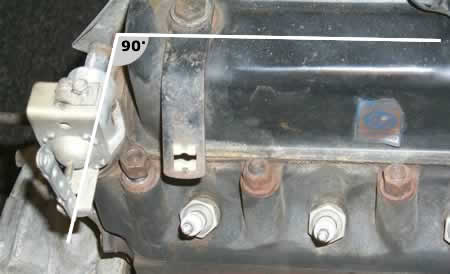
Small Bore Heater Valve
Big Bore Heater Valve
If you need more specific information than can be provided by the quick visual clues above, follow the decision tree at "Engine ID for Transverse Engines."



